Austria- Behind the Scenes: Spanish Riding School in Vienna
Tradition, history and grandeur reign supreme at the Spanish Riding School in Vienna–– home to the world famous Lipizzaner Stallions.
By Susan Seligman
Photo Credit Spanish Riding School, Vienna
It's not every day one goes to an Imperial Palace for a horse show. But in Vienna life is on a grand scale, and the Spanish Riding School is no exception. Tourists begin to arrive in fine horse drawn carriages. The clip-clopping of horses' hooves on ancient cobblestones transports us instantly into the 18th century. We imagine Austrian royalty alighting from carriages, entering the baroque luminescent white riding hall, oohing and ahhing over its Corinthian columns, crystal chandeliers and crowning decorative vaulted ceiling. Then suddenly a hush falls over the crowd as exquisitely trained white stallions perform a pax de deux in mirror -like symmetry or execute spectacular courbette or capriole leaps, thrilling the royal audience with the epitome of harmony between horse and rider. It's a sight you can still see today.
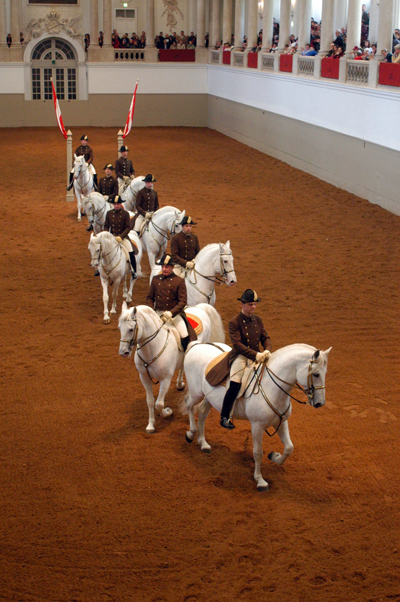
Tradition, history and grandeur reign supreme at the Spanish Riding School in Vienna. Dating from the 1500s it is the oldest riding school in the world, and home to the world famous Lipizzaner Stallions. The horses are trained and presented according to the highest principles and purest form of the classical art of riding. This extraordinary training has been handed down exclusively in an oral tradition from rider to rider for over 450 years, transforming the ancient horse strategies of war into an exquisite equine ballet of poise, elegance and grace.
The Lipizzaner Horses
The Lipizzaner horse takes its name from the village of Lipizza in present day Slovenia. The horses are the result of hundreds of years of breeding from Spanish, Italian and Arabian bloodlines. The Lipizzaners are distinguished by high set necks, relatively low withers, long powerful backs, thick tails a classic conformation and willing disposition. They are, in a word, magnificent.
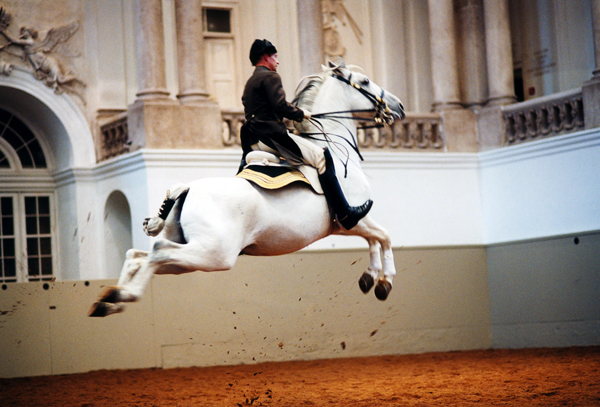
A 500 year old breeding tradition here isn't taken lightly. The horses are bred and raised in the Federal Stud at Piber, about 250 km south of Vienna in Western Styria. The breeding decisions are made by the Head Veterinarian of the Federal Stud in conjunction with the riders. Only natural cover is done, using horses whose bloodlines date back to 1750 from the original herd of the Austrian monarchy.
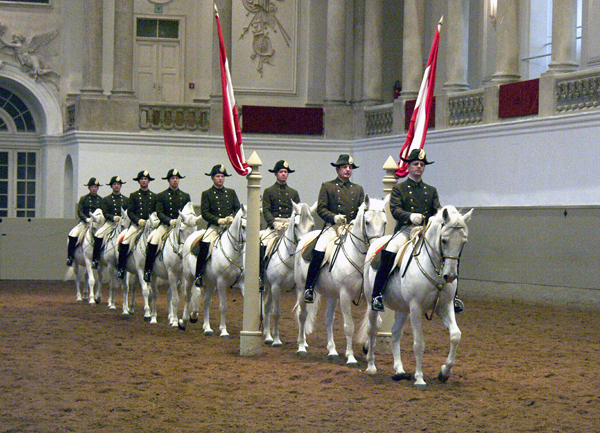
There are approximately 300 horses at Piber; fifty foals are born each year. At three and a half, twenty-five stallions are selected from that group, but only 3-5 are chosen as “good enough" to go on to be trained for the riding school. All of the riders make the selections of the horses together. If, after one or two years, there is not enough progress, the horses don't go on. It is a ten year training process before the horses are ready for the rigors of high school performances. Like people who excel in different sports, each horse is a specialist, some are best at flat work, some are born to leap, others best at executing exact maneuvers. The size of the horses is also a factor in the final selection, as the stallions have to fit into the baroque interior of the palace and stalls, built in 1735.
The Riders
The training process is long not only for the horses, but for the riders as well. Boys are selected for the school at the age of 15. Girls are not admitted as the training tradition is one of war, where females were never allowed. The school prefers boys with no previous riding experience, so mistakes don't have to be corrected. Only twenty percent of the young riders will qualify to go on to become an “Eleve", the first level of the Spanish riders. You can distinguish an “Eleve" by his blue uniform. The next level is to become an “assistant rider", wearing a brown uniform, and then assistant riders are chosen to become “riders". The highest honor is to become a Chief Rider or Oberbereiter.
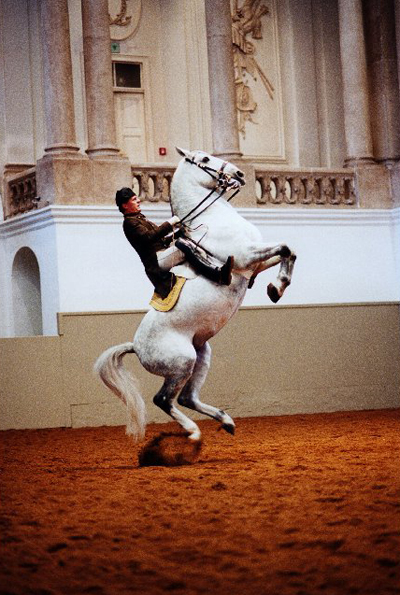
Johann Reigler is one of three Chief Riders at the Spanish Riding School a tradition that dates to 1537. There is a plaque outside of the great hall listing every Chief Rider over the last 470 years.
“Enrolling in the Spanish Riding School was not my idea‚" smiles Reigler. “I was always crazy about horses. My father had a farm. I started taking riding lessons. My riding teacher had a connection to the school and in the spring of 1969, at the age of 15 I enrolled. I didn't know what it meant to ride and train. You can practice, but you need to understand training and understand the language of riding, before you become a rider. One can play an instrument, but without the understanding, one doesn't play music. I've spent 43 years, practically my whole life with Spanish horses, and I am always learning."
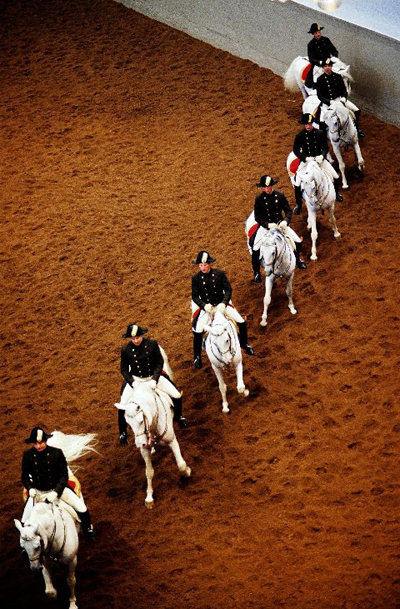
Reigler emphasizes that the classical training passed down for generations here is all about flexibility and the natural movement of the horse. “It's essential training, whether you are training for high school moves or for sport," he says.
Uniforms
Riders are always in uniform, during training or a performance. You will never see anyone riding in jeans or a t-shirt. The uniform has been the same for over two hundred years; a bi-corner black felt hat with gold trim, a high closed brown wool tunic with gold buttons, deerskin breeches and gloves of the same color. Black leather boots cover the knees for protection.
We are surprised when we spot the riding crops, seemingly nothing more than long sticks. But they are much more than sticks, and their selection is steeped in tradition. Riders hike into the woods late January or early February to select the perfect crop from white birch branches while the wood is still dry. Traditions and superstitions are a huge factor in finding just the right branch of birch. Some riders will only go to certain forests; others watch the moon to see which day will be best for collecting or keep their selection date and time a secret. After selection, ten branches are hung together to straighten them and ends are then soaked in water and shaped. The crops can last for years.

Classical Riding
The performance of the highly trained stallions is a combination of many incredible moves. Each program begins with basic steps and movements, and then continues with extraordinary steps; the Piaffe, Passage, side stepping and backward stepping. Next the horses and riders perform the Pas de Deux, a beautiful symmetrical dance of two horses. Movements on the Short Rein and Long Rein are the next part of the program. But the real crowd-pleaser is always the Schools above the ground, consisting of the Pesade, the Levade, the Courbette and the Capriole. The precision school quadrille is the thrilling grand finale.
How to See the Lipizzaner Stallions
Plan your visit to take in one of the weekly gala performances. Visitors can also purchase tickets for the morning exercise program or the Privatissimum, a special performance where instructors demonstrate the training, traditions and history of the Spanish Riding School. Don't miss the nearby Lipizzaner Museum for terrific history and insight into the horses, the riders and the school. You can also visit the Stud at Piber for a behind the scenes look at the beginning training of the young stallions as well as watch international dressage tournaments or listen to romantic concerts. For further information, log on to www.srs.at.




